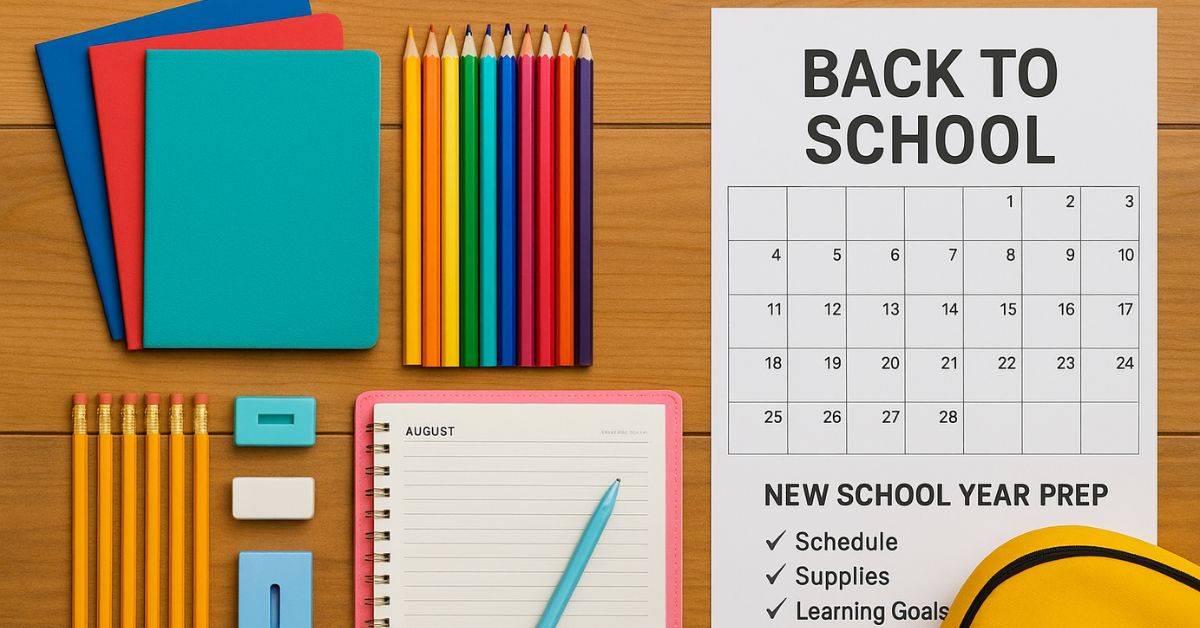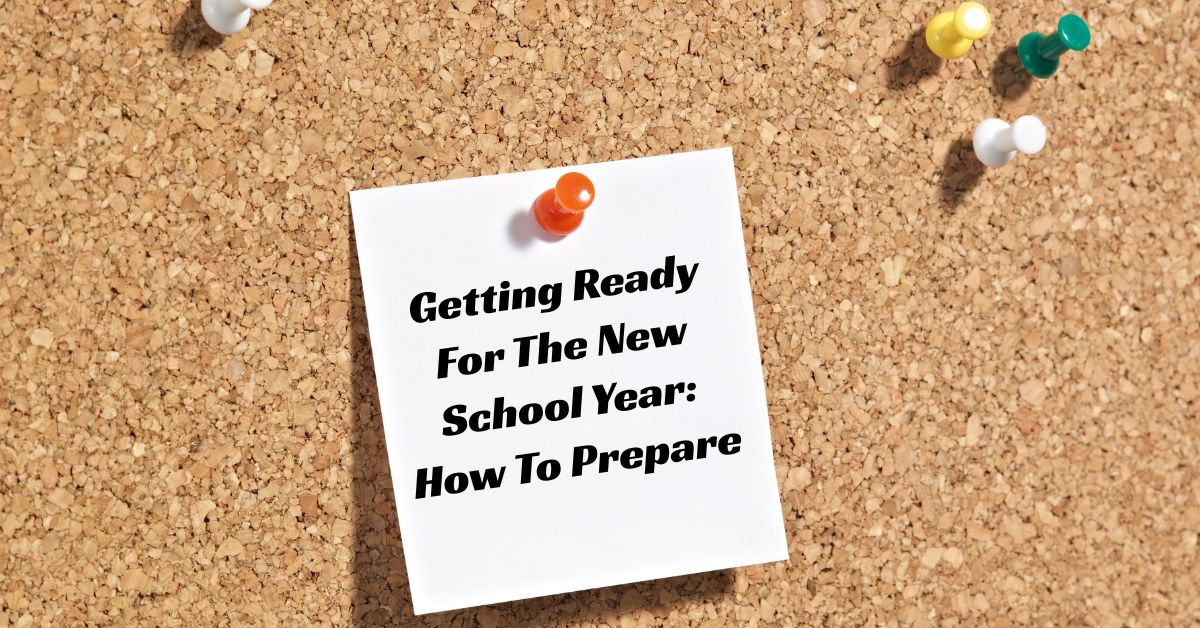Preparing for a new homeschool year requires careful planning and organization. Creating a structured environment, organizing needed materials, and crafting a schedule tailored to your child can simplify the process and set your family up for success. This guide is packed with practical and actionable insights to help you tackle homeschool back-to-school prep with confidence.
Step 1: Create A Functional And Inspiring Homeschool Space
Your homeschool environment plays a vital role in your child’s learning experience. A well-thought-out space doesn’t just help kids stay engaged; it also minimizes distractions and fosters a sense of routine. Follow these steps to build an efficient and inviting homeschool space:
- Declutter and Deep Clean
Begin by clearing out materials from the previous school year. Discard or recycle old projects, unused workbooks, and supplies that are no longer needed. Keeping your space tidy creates room for new materials and fresh ideas.
- Organize by Subject or Activity
Designate specific areas for different subjects or tasks. For example:
-
- A bookshelf organized by subjects (math, science, history, etc.) ensures clarity and accessibility.
-
- A small table can serve as a dedicated art station with easy-to-clean surfaces and tool organizers.
- Use Storage Solutions Wisely
Maximize your space by incorporating multi-purpose storage tools. Here are some ideas:
-
- Labeled bins or clear containers for supplies like markers, scissors, and rulers.
-
- Over-the-door organizers for items like flashcards and craft supplies.
-
- Stackable drawers for bulkier teaching aids like math manipulatives or science kits.
- Create A Visual Planner Hub
A “command center” is a dedicated space where schedules, to-do lists, and progress-tracking tools are displayed. Use:
-
- A large wall-mounted whiteboard for lesson plans and weekly goals.
-
- A family calendar to track extracurricular activities or project deadlines.
-
- Cork boards or clipboards to pin your kids’ outstanding work or highlight major accomplishments.
- Add Personal Touches
Decorate the space with items that inspire creativity and learning:
-
- Hang artwork created by your child or motivational quotes to keep spirits high.
-
- Add cozy seating options like beanbags in a reading nook for a relaxed atmosphere.
By dedicating time to setting up an organized, multi-functional space, you create an environment that encourages focus and curiosity.

Step 2: Plan A Balanced And Adaptable Homeschool Schedule
Homeschooling provides flexibility, but even flexible learning thrives with a plan. To ensure every subject gets adequate attention without overwhelming children (or parents), a structured yet adjustable schedule is key.
Building a Framework
- Prioritize Core Subjects First
Core areas like math and language arts often require more focus. Schedule these subjects earlier in the day when children are most alert and ready to learn.
- Introduce Rotating Activities and Breaks
Alternate between high-focus lessons and creative or physical activities. For example:
-
- Morning focus on structured lessons such as math and science.
-
- Midday switch to projects, art, or music lessons.
-
- Late afternoons reserved for outdoor activities or family tasks like gardening.
- Tailor the Routine for Different Ages
If your children are at different grade levels, stagger their schedules accordingly:
-
- Older children can tackle independent learning blocks while you assist younger ones.
-
- Using audiobooks or educational videos can keep one child engaged while you work one-on-one with another.
Maintaining Flexibility
- Prepare for Interruptions
Include a “buffer zone” in your schedule. This time can help catch up on missed lessons or accommodate spontaneous learning opportunities such as field trips or nature walks.
- Integrate Downtime into the Day
Learning requires rest, too. Plan snack breaks, free reading periods, or even quiet time where kids can relax and recharge.
- Keep It Visible and Editable
Whether you prefer a printed weekly planner or a magnetic board in your schoolroom, keep the schedule where the whole family can reference it. Encourage kids to contribute ideas or vote on weekly activities to involve them in planning.
A functional homeschool schedule should strike a balance between structured lessons and flexible, interest-driven activities. This balance keeps the momentum going throughout the school year while leaving plenty of room for creativity and fun.
Step 3: Stock Up On Supplies And Optimize Curriculum Choices
Having the right supplies and curriculum tools in place helps eliminate last-minute stress. Carefully gathering materials and refining your teaching resources sets the stage for a smooth homeschool experience.
Essential Supplies Checklist
Before the first day, stock up on:
- General Supplies
-
- Basic tools like pencils, erasers, highlighters, and notebooks.
-
- Folders or binders to organize completed work and resource sheets.
- Specialized Materials
-
- For STEM activities, gather items like lab equipment, measuring tools, or robotics kits.
-
- Art and craft supplies including paints, brushes, sketchbooks, and glue.
- Miscellaneous Essentials
-
- A laminator for reusable resources like charts or flashcards.
-
- Noise-canceling headphones to help focus during independent work.
A quick trip to the store or an online order at the start of the season ensures you’ll have everything from math manipulatives to science experiment kits at hand.
Reviewing Curriculum Options
Each homeschool year is an opportunity to refine what works best for your child.
- Reflect on Previous Year’s Successes
Were your children engaged by certain textbooks, projects, or lesson approaches? Use these insights to inform the year ahead.
- Blend Digital with Traditional Tools
Balance printed textbooks with online platforms or apps that offer interactive lessons. EdTech tools often include features like quizzes and progress-tracking dashboards, making assessments more engaging.
- Join Curriculum Exchanges or Networks
Communities of homeschool parents often share or sell gently used resources. Facebook groups, co-op meetings, or local homeschool fairs can be a budget-friendly way to experiment with new content.
Organize Your Resources
Prevent future headaches by establishing an organizational system from day one:
- Group physical textbooks and workbooks by subject.
- Use digital folders to catalog online subscriptions or download printable worksheets.
Keeping things streamlined ensures you’ll be prepared for both planned lessons and spur-of-the-moment adjustments.
Step 4: Infuse Fall Themed Learning Into Your Plan
One of the perks of homeschooling is the ability to adapt lessons around seasonal themes. Fall, with its vibrant colors and crisp air, provides abundant opportunities to explore nature and incorporate experiential learning into your curriculum.
Seasonal Learning Activities
- Outdoor Science Experiments
Use the changing season for hands-on projects:
-
- Study why leaves change colors by collecting samples to examine under a magnifying glass or microscope.
-
- Build weather-related experiments such as creating your own barometer to explore autumn pressure systems.
- Harvest-Based Math and Art Projects
Integrate the fall harvest into learning:
-
- Younger children can group apples or pumpkins for counting and sorting exercises.
-
- Older kids might explore geometry by designing corn maze blueprints or calculating the area of irregularly shaped garden plots.
- Stories and Writing Prompts Inspired by Autumn
Incorporate autumnal storytelling into language arts. For example:
-
- Read books set during harvest times or leaf-filled adventures and have students write alternative endings.
-
- Assign creative essay topics like “If I Were a Falling Leaf…”
Incorporating Outdoor Education
Set aside time to explore the natural world as it transitions into fall:
- Have kids create leaf rubbings or acorn diagrams after a nature walk.
- Take a trip to a local farm and document your observations through sketches, charts, or reflective journal entries.
Seasonal activities don’t just add whimsy to your homeschool—they boost engagement and deepen kids’ natural curiosity, making the back-to-school season memorable.
Actionable Steps to Get Started
While homeschool prep may seem daunting, tackling one task at a time and using the practical tips outlined above will make it more manageable. Create an organized learning space, finalize a schedule, stock up on resources, and celebrate the fall season’s learning opportunities. By taking intentional and small steps now, you’re laying a solid foundation for a successful school year ahead. Invite your children into the process whenever possible—it’s a great way to nurture buy-in and enthusiasm for the months to come.



